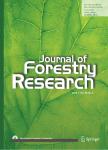Biomass production and carbon balance in two hybrid poplar(Populus euramericana)plantations raised with and without agriculture in southern France
Biomass production and carbon balance in two hybrid poplar (Populus euramericana) plantations raised with and without agriculture in southern France作者机构:UMR SystemsInstitute Nationale de la Recherche Agronomique2 place Pierre Viala34060 MontpellierFrance Technical ForestryIndian Institute of Forest ManagementBhopalIndia
出 版 物:《Journal of Forestry Research》 (林业研究(英文版))
年 卷 期:2018年第29卷第6期
页 面:1689-1701页
核心收录:
学科分类:0907[农学-林学] 08[工学] 0829[工学-林业工程] 09[农学]
基 金:financially supported by European Union and INRA
主 题:Populus euramericana Wood volume and density Root:shoot ratio Vegetation and soil carbon System efficiency
摘 要:Poplar is useful in different climates for bioenergy production and carbon sequestration when planted as a single species or in agroforestry. Europe has large areas potentially suitable for poplar forestry and a bioenergy policy that would encourage poplar forestry. In this study I estimated biomass production and carbon sequestration in poplar monoculture plantation and poplar-wheat agroforestry, in the Mediterranean region of France. A single-tree harvesting method was used to estimate biomass and an empirical conversion factor was adopted to calculate sequestered carbon. Total biomass was higher in agroforestry trees(1223 kg tree) than in monoculture plantation trees(1102 kg tree).Aboveground and belowground biomass distributions were similar in both cases(89 and 88% aboveground, and 11 and12% belowground, respectively in agroforestry and monoculture). The partitioning of total biomass in an agroforestry tree in leaves, branch, and trunk(aboveground), and fine roots, medium roots, coarse roots and underground stem(belowground) was 1,22,and 77,and 6,9, 44 and 40%,respectively. Except for branch and trunk, all other compartments were similarly distributed in a monoculture *** of C was higher in agroforestry trees(612 kg tree)than in monoculture trees(512 kg tree). In contrast, C storage on a per hectare basis was lower in agroforestry(85 Mg ha) than in monoculture(105 Mg ha) due to the lower density of trees per hectare in agroforestry(139 trees in agroforestry vs 204 trees in monoculture). On a per hectare basis, soil C stocks pattern were similar to per tree stocking:They were higher in agroforestry at 330 Mg hathan in monoculture 304 Mg ha. Higher C accumulation by agroforestry has a direct management implication in the sense that expanding agroforestry into agriculture production areas with short rotation and fast growing trees like poplar would encourage quicker and greater C sequestration. This could simultaneously fulfil the requirement of bioenergy



